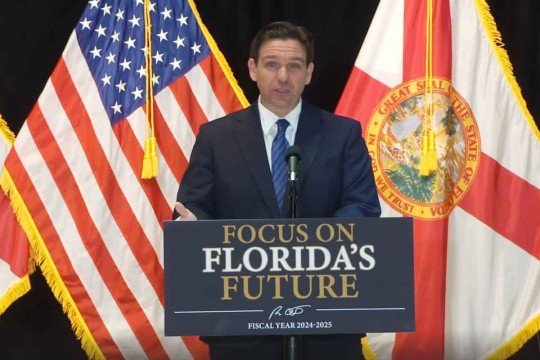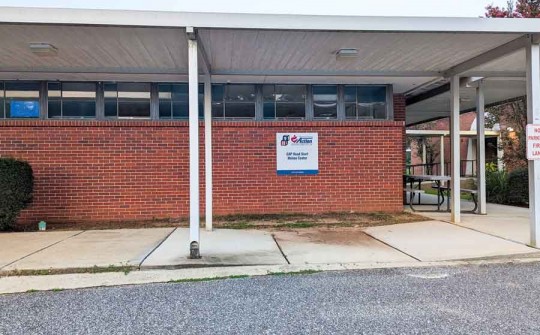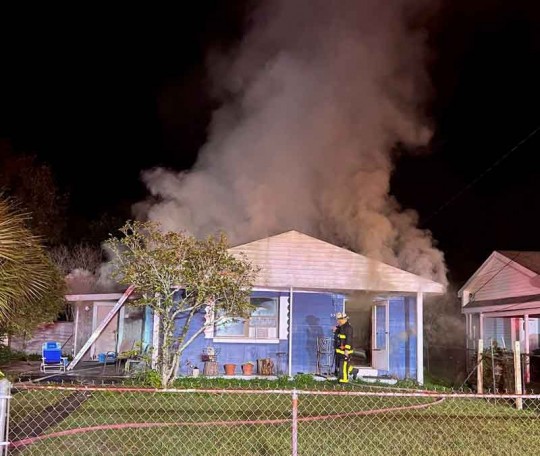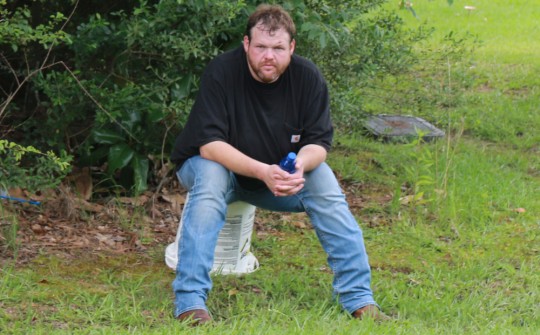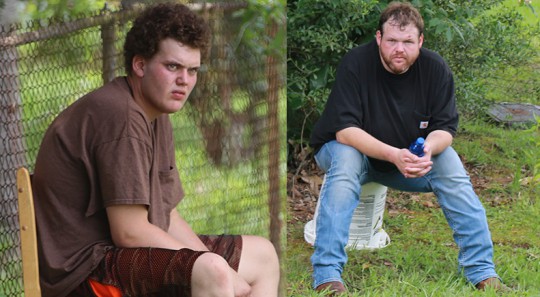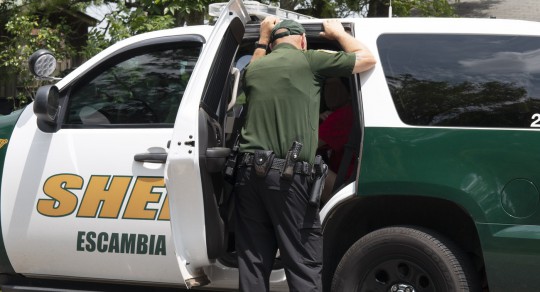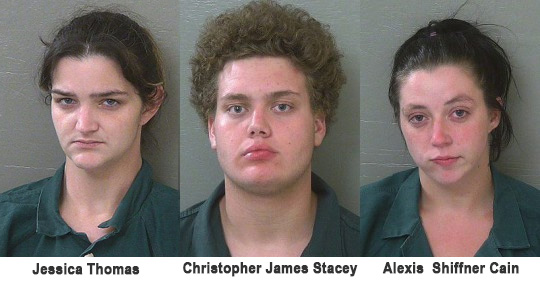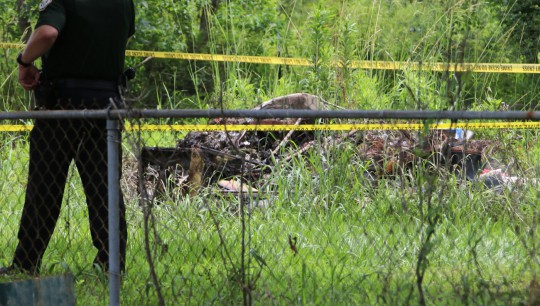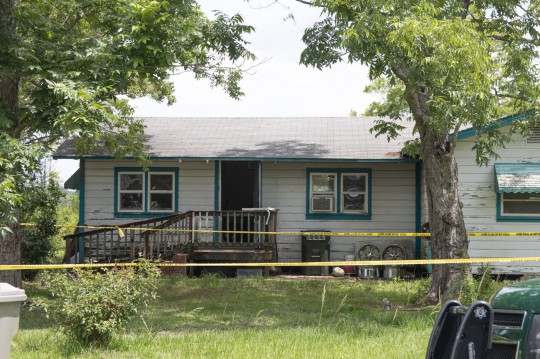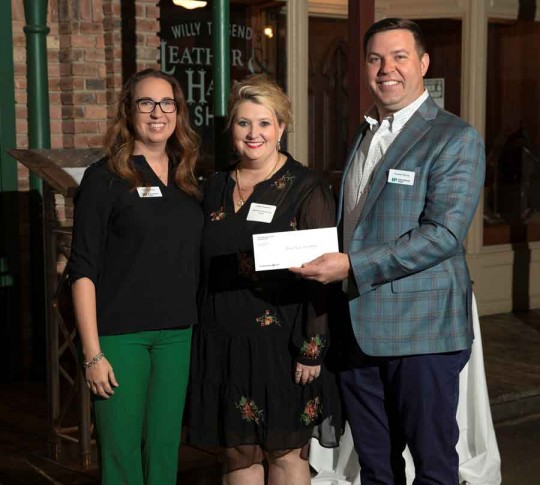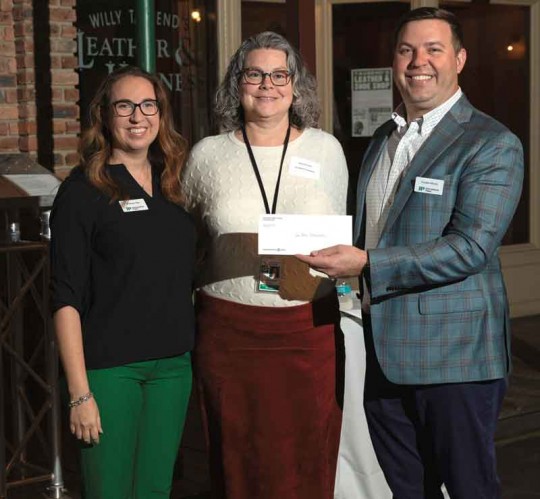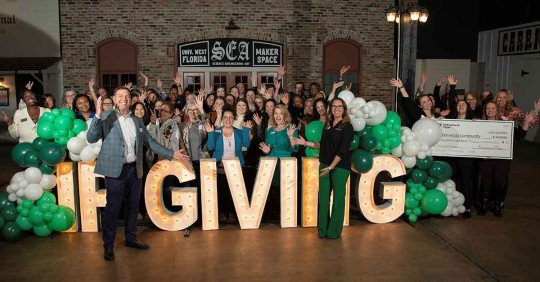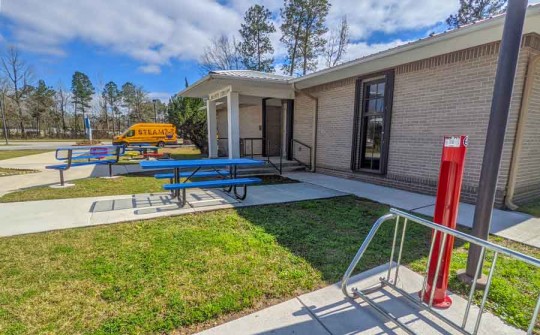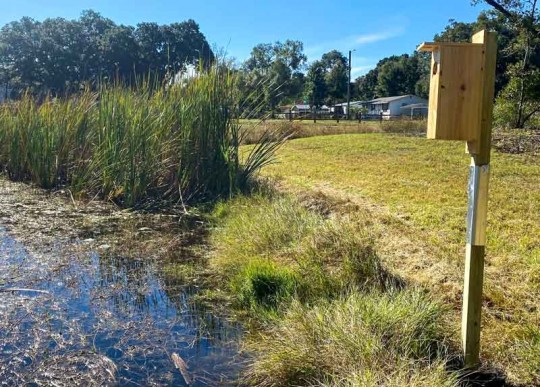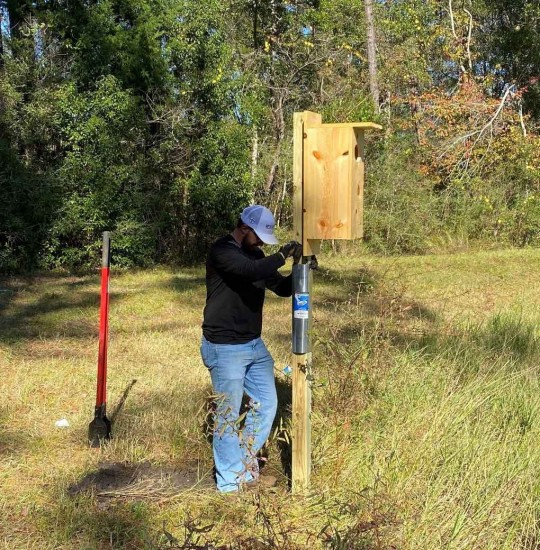DeSantis Announces $114.4 Billion Budget Plan
December 6, 2023
Tuesday, Governor Ron DeSantis announced his Focus on Florida’s Future budget proposal for Fiscal Year (FY) 2024–2025. The Focus on Florida’s Future Budget totals $114.4 billion, more than $4.6 billion less than the current year budget, with $16.3 billion in reserves, leaving ample resources for any unforeseen economic issues.
Florida has experienced record success over the last five years, ranking #1 in education, net in-migration, entrepreneurship, and new business formations, with 2.7 million new businesses formed since 2019. The Governor’s Budget also continues Florida’s record as the nation-leading example of success through fiscal conservatism by paying down an additional $455 million in debt and providing $1.1 billion in tax relief.
“Success is not something that is handed to a state as large as Florida, it requires a steadfast commitment to supporting families at every step,” said Governor Ron DeSantis. “By expanding workforce education for high-demand jobs, providing family-first tax relief, ensuring that Florida’s students can access a quality education that fits their needs, investing in resilient infrastructure and putting conservative principles at the forefront of every decision, we have delivered time and again for our residents. Florida’s success is proof positive that when you establish a foundation of governing on conservative principles and protect the freedom of your residents, success will follow. I look forward to seeing what we can accomplish over the next year.”
Family Focused Tax Relief
The Governor’s Budget recommends more than $1.1 billion in tax relief for Florida families for Fiscal Year 2024–2025. The tax relief package focuses on reducing the cost of homeowners insurance in addition to sales tax holidays for items that families need throughout the year. The tax package for the Focus on Florida’s Future Budget includes:
- A one-year exemption on taxes, fees and assessments for Homeowners Insurance Policies, saving taxpayers $409 million and decreasing the average insurance premium by up to 5%.
- A permanent exemption on Flood Insurance Policies, saving taxpayers $22 million over the year.
- A permanent sales tax exemption on over-the-counter pet medications, saving Florida families $37 million and helping keep our family pets healthy.
- A tax credit for businesses that employ Floridians with unique abilities, saving these businesses $5 million annually.
- Two Back-to-School sales tax holidays, one in the fall and one in the spring. This will save Florida families $169 million on school supplies, clothing and computers.
- Two Disaster Preparedness sales tax holidays, saving Floridians $49 million on supplies needed during disasters.
- A three-month Freedom Summer sales tax holiday, saving Florida families more than $241 million on outdoor recreation items to entertain the kids during the summer.
- A 7-day Tool Time sales tax holiday, saving skilled workers more than $16 million on tools they need for work.
- An increase of the sales tax collection allowance to save small businesses $165 million.
Investing in Florida’s Property Insurance Market
Since passing record reforms to improve Florida’s property insurance market, conditions continue to make promising improvements. In addition to providing tax relief to reduce the cost of homeowners insurance, the Focus on Florida’s Future Budget invests over $109 million to support residential home mitigation programs and additional oversight of the property insurance market, including:
-
- $107 million in annual funding to make the My Safe Florida Home Grant Program permanent and continue assisting Florida homeowners through home inspections and cost sharing for approved home hardening and wind mitigation programs to reduce premiums and make properties less vulnerable to hurricane damage. This investment follows additional funding provided during the recent Special Session and is especially important as Floridians are recovering following hurricanes Ian, Nicole and Idalia.
- $1.1 million in funding to bolster the Florida Office of Insurance Regulation’s (OIR) ability to curate data related to Florida’s property insurance market.
- $675,000 to contract for independent reinsurance and mitigation research experts to bolster OIR’s ability to review filings and recommend new tools to mitigate properties from hurricanes.
Educating Florida’s K–12 Students
Florida is the education state, ranking #1 in a variety of different educational categories, including overall education and education freedom. Florida has prioritized providing our students with a high-quality education that fits their individual needs. The Focus on Florida’s Future Budget builds on Florida’s record investments in education, providing a historic $27.8 billion in funding for the K–12 public school system. This will include the highest per student investment ever, providing $8,842 per student, an increase of $175 over last year. This investment will also cover the costs of the more than 274,000 students who are projected to participate in Florida’s school choice program, the Family Empowerment Scholarship.
Additional funding highlights for Florida’s K12 students include:
- $1.25 billion to provide salary increases for teachers and other instructional personnel, an increase of $200.6 million over FY 2023-2024.
- $1.6 billion for early childhood education, including $450 million for voluntary pre-kindergarten programs.
- $290 million for the Safe Schools Initiatives, an increase of $40 million over FY 2023-2024.
- $52.8 million to support civics engagement programs, including $45 million for the Florida Civics Seal of Excellence Program.
Florida is also continuing to prioritize the safety of our Jewish Day Schools in the midst of rising antisemitism. The Governor’s Budget recommends $10 million for enhanced security measures at Jewish Day Schools across the state. To continue educating Florida’s students on the atrocities of the Holocaust, the Governor’s Budget recommends $1.35 million for the Florida Holocaust Museum.
Florida Leads the Nation for Higher Education
Florida has ranked #1 for Higher Education for seven years in a row, while also holding the line on tuition to provide a quality education at an affordable price. The Governor’s Budget builds on Florida’s success and ensures that Florida will continue to have the top education system in the country.
For colleges and universities, the Governor’s Budget recommends:
- $1.7 billion for the Florida College System.
- $3.7 billion for the State University System.
- $150 million for recruitment and retention of quality faculty at our state colleges and universities.
- $152 million for Florida’s Historically Black Colleges and Universities, including $10 million for HBCU facility hardening to prevent anyone from targeting HBCUs with violence.
Providing a quality education that leads to quality jobs is an important part of ensuring that Florida’s workforce can continue to meet the demand of the job market. When the Governor took office, he set a goal of being the best state in the nation for workforce education by the year 2030, and Florida is well on its way to meeting this goal, investing more than $8 billion in workforce education since 2019. The Governor’s Budget continues this progress by investing a historic $853 million for workforce education programs, ensuring that Floridians can continue to access workforce education opportunities that lead to high-demand, high-wage jobs. This investment includes:
- $125 million for nursing education programs to help address nursing vacancies.
- $35 million for the Open-Door Grant Program to support workforce education programs operated by school districts and state colleges.
- $20 million for the Governor’s Pathways to Career Opportunities Grant Program to support pre-apprenticeship and apprenticeship programs for high school and college students.
The Governor’s Budget also includes $35 million for the Florida Semiconductor Institute at the University of Florida to support workforce development for semiconductor manufacturing and research and development.
Supporting Florida’s Economic Development
Florida is the fastest growing state in the nation because Governor DeSantis has championed freedom first policies and continued investments that create opportunities for Florida families to thrive. The Focus on Florida’s Future Budget continues to make smart investments to support Florida’s infrastructure, workforce and economy to ensure they can continue to meet the demand of our growing state.
Rather than sit idly by as the federal government continues to politicize infastructure investments, the Focus on Florida’s Future Budget prioritizes investments that reduce congestion and expedite the movemnt of goods through the state’s supply chain.
To support Florida’s transportation network and infrastructure, the Focus on Florida’s Future Budget invests:
- $14.5 billion for the state transportation work program to construct and maintain Florida’s transportation network.
- $630 million for the 2nd phase of the Moving Florida Forward Initiative, expediting 20 projects to relieve traffic congestion.
- $75 million for Florida’s ports, logistics centers and fuel pipelines, including vertiport development.
- $25 million to expand the Truck Parking Improvement Program to increase the number of parking spots available in Florida to cargo- hauling large trucks.
To help create new jobs and support business development throughout the state, the Governor’s Budget invests:
- $100 million for the Job Growth Grant Fund to support local infrastructure and workforce training projects.
- $105 million to continue marketing efforts through VISIT FLORIDA.
- $175.2 million for the State Small Business Credit Initiative, providing small businesses with access to capital to grow their business.
Florida’s rural communities are an important part of the success of our state and the Governor’s Budget continues to provide our rural communities with the resources they need to thrive. This includes:
- $25 million for the Rural Infrastructure Fund to support local infrastructure projects that help attract jobs.
- $100 million to expand broadband internet access in rural communities.
- $88.1 million for the Small County Outreach Program to assist small county governments in repairing infrastructure.
As Florida continues to grow and attract new workers, it is important to ensure that they can access housing in the communities in which they work. To support workforce housing, the Governor’s Budget includes:
- $208.6 million for the State Housing Initiatives Partnership (SHIP) program.
- $89.5 million for the State Apartment Incentive Loan (SAIL) program.
- $100 million for the third year of the Hometown Heroes Housing program to provide down payment and closing cost assistance for first-time homebuyers.
Economic Support for Law Enforcement and the Military
Governor DeSantis has always recognized the invaluable contributions made to Florida by its law enforcement and military communities. To support Florida’s law enforcement and military communities, the Focus on Florida’s Future Budget includes:
- $20 million for the third year of the Law Enforcement Recruitment Bonus Program, which provides a signing bonus of up to $5,000 for those hired as first-time law enforcement officers in Florida.
- $7 million for the Defense Infrastructure Grant Program, which provides funding for infrastructure projects that make a positive impact on the military value of installations within the state.
- $3 million of increased funding for the Florida Defense Support Task Force, which supports the Florida defense industry by awarding grants and guiding the future of military installation operations in the state.
- $2.2 million of increased funding for the Military Base Protection Program, which helps secure non-conservation lands to serve as a buffer protecting military installations from encroachment and supports local community efforts to engage in service partnerships with military installations.
Everglades Restoration and Water Quality
Florida’s natural resources are directly tied to the economic resilience of the state and provide important defenses against natural disasters such as hurricanes. Florida has made record investments in protecting our natural resources and conserving the Florida way of life and Governor DeSantis continues this commitment in the Focus on Florida’s Future Budget.
During Governor DeSantis’ first term as Governor, he signed record investments to protect Florida’s Everglades and support water quality, investing a record $3.3 billion. At the start of his second term, he called for a historic $3.5 billion investment over the next four years. The Governor’s Budget recommends $1.1 billion for Everglades restoration and water quality, bringing the total investment during the Governor’s second term to $2.8 billion. This investment includes $745 million for Everglades restoration projects:
- $550 million for the Comprehensive Everglades Restoration Plan (CERP).
- $64 million for the EAA Reservoir to continue the momentum of this critical project to reduce harmful discharges and help send more clean water south of the Everglades.
- $50 million is included for specific project components designed to achieve the greatest reductions in harmful discharges to the Caloosahatchee and St. Lucie Estuaries.
- $81.5 million is included for the Northern Everglades and Estuaries Protection Program.
- $3 million for the Florida Fish and Wildlife Conservation Commission to remove pythons from the Everglades.
To continue protecting Florida’s water quality and supply, the Governor is recommending $330 million for targeted water quality improvements to achieve significant, meaningful and measurable nutrient reductions in key waterbodies. This includes:
- $135 million for the expanded Water Quality Improvement Grant Program for projects to construct, upgrade or expand wastewater facilities, including septic to sewer conversions, stormwater management projects and agricultural nutrient reduction projects.
- $100 million for the Indian River Lagoon (IRL) Protection Program for priority projects to improve water quality in the IRL, as called for in Executive Order 23-06.
- $50 million to accelerate projects to meet scientific nutrient reduction goals, called Total Maximum Daily Loads.
- $20 million for critical infrastructure including wastewater and stormwater projects that address water quality impairments and coral reef restoration in Biscayne Bay.
- $25 million for water quality improvements in the Caloosahatchee River watershed.
Additional water quality investments include $50 million to restore Florida’s world-renowned springs and for land acquisition to protect springsheds as well as more than $55 million to improve water quality and combat the impacts of harmful algal blooms, including blue-green algae and red tide. The Focus on Florida’s Future Budget includes $80 million for the Alternative Water Supply Grant Program to help communities plan for and implement vital conservation, reuse and other alternative water supply projects.
To support conservation lands and to protect the great outdoors for generations of Floridians to enjoy, the Governor’s Budget invests $50 million in Florida’s State Parks for infrastructure improvements and resource management with the goal of maintaining Florida’s world class parks which have won the National Gold Medial a record four times. The Governor’s Budget also includes more than $125 million to protect Florida’s conservation lands and waterways to ensure Florida’s prized properties are accessible for future generations of Florida families. This funding includes $100 million for the Florida Forever Program, the state’s blueprint for conserving Florida’s natural and recreation lands, including those located within the Florida Wildlife Corridor.
Florida is home to 1,300 miles of coastline which plays an important role in Florida’s economy and quality of life, attracting visitors from across the world and providing an invaluable defense against hurricanes. The Governor’s Budget includes $50 million in beach nourishment funding to bolster our shorelines. Additionally, the Governor is recommending $22.8 million for coral reef protection and restoration, including $11.3 million to continue Florida’s Coral Reef Restoration and Recovery Initiative established in Executive Order 23-06, to restore 25 percent of Florida’s Coral Reef by 2050.
The Governor’s Budget also prioritizes the protection of Florida’s working agricultural lands and family farms, providing an annual appropriation of $100 million to the Rural and Family Lands Protection Program to enter into perpetual conservation easements. In order to preserve Florida’s iconic citrus industry, the budget invests more than $20 million for citrus research and the Citrus Health Response Program. This includes $5 million for research and additional advertising by the Department of Citrus.
To further protect Florida’s rural areas and communities surrounded by Florida’s beautiful forests, the Governor’s Budget provides $4 million to support the replanting of trees and timber impacted by hurricanes and natural disasters, in addition to investing over $30 million in Florida’s efforts to effectively combat wildfires including equipment, road and bridge maintenance and Wildfire Protection and State Forest operations.
The Focus on Florida’s Future Budget also includes $211 million for the cleanup of contaminated sites with a focus on promoting redevelopment of these areas once cleanup has been completed.
Supporting Disaster Response, Recovery and Mitigation
In 2023, Governor DeSantis, the Division of Emergency Management, state agencies and local partners rose to the significant challenges imposed by disasters including hurricanes Ian, Nicole and Idalia. The Governor’s Budget provides $1.3 billion in state and federal funding for disaster recovery, mitigation and emergency management to continue helping Floridians impacted by a disaster while preparing for future disasters.
This includes $199.9 million in state match provided for the state cost share associated with authorized federal funding to eligible local and state recipients for reimbursement of the response and recovery cost, as well as state management costs relating to federally declared disasters.
Additionally, the Focus on Florida’s Future Budget includes $396 million in additional federal Community Development Block Grant (CDBG) funds for local hurricane recovery and hardening efforts throughout the state, including the CDBG Disaster Recovery Program and the CDBG Mitigation Program.
Investing in a Healthier Florida
Governor DeSantis has been steadfast in his commitment to supporting the healthy lives of Floridians. This includes providing support for those struggling with mental health and substance abuse and victims of human trafficking in addition to supporting Florida’s seniors, Floridians with unique abilities, veterans, and Florida’s mothers and children. The Governor has also prioritized critical cancer research and innovative treatments.
To support mental health resiliency and those suffering from substance abuse, the Governor’s Budget recommends:
- More than $294 million to support behavioral health services, including enhanced mobile response services, collaboration between primary care and behavioral health providers to support crisis diversion and avoid high-cost acute care and additional support for mental health treatment facilities, competency restoration services, and enhancements to the suicide hotline services.
- More than $150 million from the nationwide opioid settlement to continue support for the Office of Opioid Recovery, an accredited Graduate Medical Education program to increase the number of psychiatric residents, and for other initiatives that support education, treatment, and prevention for individuals with substance use disorders.
- $31.8 million to continue expansion of the CORE Network across the state, which has already served thousands of Floridians.
To support important cancer research, the Governor’s Budget includes:
- More than $232 million in funding for cancer research, including $60 million, a 200% increase over FY 2023-2024, for the Florida Cancer Innovation Fund that supports groundbreaking cancer research stemming from emerging ideas, trends, and promising practices that can be replicated and expanded upon in Florida.
- $127.5 million for the Casey DeSantis Cancer Research Program.
To support Florida’s mothers, their children, and the children in the child welfare system, the Governor’s Budget invests:
- Increased funding of $447 million to support the care of pregnant women and children. This will help to improve access to obstetric care for pregnant women and to support care for seriously ill children and babies.
- More than $103 million to support those served by the child welfare system. Funding will support foster parents and caregivers, community-based services, local prevention grants, and additional family navigators to connect high risk families and children to resources and supports through collaboration with front line child protective investigators.
- An increase of $13.5 million, for adoption subsidies to provide continued support to those who have adopted children from the child welfare system.
- $9.8 million to expand the existing program that provides adoption incentives to groups that include state employees, school district personnel, and law enforcement officers.
- $6 million to provide additional services for victims of human trafficking. The funds will support housing for additional survivors to support their recovery.
To support Florida’s seniors, the Governor’s Budget recommends:
- $6 million to serve additional seniors as part of the Alzheimer’s Disease Initiative.
- More than $2 million in additional funding for the Florida Alzheimer’s Center of Excellence.
- $15 million is provided to increase services through the Community Care for the Elderly Program and the Home Care for the Elderly Program. Funding will provide additional support for seniors at risk for out of home placement.
To support Floridians with unique abilities, the Focus on Florida’s Future Budget invests more than $127 million in funding to allow additional individuals with disabilities to be provided necessary services through the Home and Community Based Services Waiver. The budget also provides for the expansion of the pilot project aimed at supporting individuals who have both a developmental disability and mental health diagnosis to receive evaluation and treatment in the most appropriate setting. Funding is also provided to support the planning of implementation of a new waiver aimed at providing targeted services for adults with unique abilities who are entering adulthood.
The Governor’s Budget invests an additional $8.9 million to support additional equipment and capital improvements for the State Veterans’ Nursing Homes. The budget also includes $102 million to begin the construction of the ninth State Veterans’ Nursing Home in Collier County upon federal grant approval. Additionally, $2 million is recommended to assist veterans in securing meaningful skills-based employment, provide employers with a skilled talent pipeline, and assist veterans in creating and operating a small business.
Let The Tate Band Do All Of Your Gift Wrapping This Year
December 6, 2023
The Tate Band Showband of the South will be wrapping gifts for donations through Christmas Eve. Look for the tent at JCPenney on North Davis Highway.
The band will be wrapping gifts December 16-21 from noon until 8 p.m. each day,and December 22-24 from 10 a.m. until 10 p.m.
County Set To Renew Head Start Lease At Molino Community Center
December 6, 2023
Escambia County is set to renew a lease with the Community Action Program Committee for a portion of the Molino Community Center that is used for a Head Start program.
The non-profit will pay $5 in advance for a five-year term under a lease agreement to be considered by the Escambia County Commission at their next meeting on December 7.
Head Start and Early Head Start Programs provide comprehensive, developmental services for low-income pre-school children ages birth to five and support services for their families. The purpose of the Head Start programs is to promote school readiness by enhancing the social and cognitive development of children through the provision of health, educational, nutritional, social and other services. The cornerstone of the program is parent and community development.
The program has operated at the Molino Community Center since 2014.
NorthEscambia.com photo, click to enlarge.
Two Charged After Drug Raid In Atmore
December 6, 2023
Two people are facing multiple drug charges after a drug raid in Atmore.
Atmore Police narcotics agents executed the search warrant on Sims Street. Officers reported the recovery of over 10 grams of methamphetamine, over 50 grams of synthetic cannabis, a small amount of marijuana, a scale, a grinder, and numerous plastic baggies and sandwich bags commonly used to distribute narcotics.
Devon Pace, 40, and Stephany Rice, 27, both of Atmore were charged with unlawful possession with intent to distribute a controlled substance, possession of a controlled substance, and possession of drug paraphernalia. Both were booked into the Escambia County (AL) Detention Center.
First Red Bulb Placed on Wreath During “Keep the Wreath Green” Campaign
December 6, 2023
Escambia County Fire Rescue has placed the first red bulb on the wreath in 2023 following a residential structure fire Monday evening.
At 10:47 p.m. on Monday, Escambia County Fire Rescue units E11, E16, E17, SQ3, L12, S4, BC2 and BC3 responded to a residential structure fire at the 50 block of Teakwood Drive. Upon arrival, a single-story home was showing flames and smoke. Rapid water application limited the fire to one of the bedrooms. However, one cat was found deceased inside the home due to the fire. There were no additional injuries or fatalities. Due to the damages, the occupants were displaced and assisted by the American Red Cross. The home can be tenable again with repairs. ECFR conducted the investigation and determined the cause was due to an overloaded power strip.
The “Keep the Wreath Green” fire safety campaign is a collaborative initiative with the City of Pensacola to promote fire safety during the month of December. During the month-long campaign, five-foot wreaths are on display at 21 county fire stations and five city fire stations, as well as Escambia County’s Ernie Lee Magaha Government Building downtown, the Escambia County Public Safety Building and Pensacola City Hall. Each time firefighters respond to a residential fire with damage, a green light bulb will be replaced with a red one to remind citizens of the dangers posed by fires in a residential home.
Man Facing List Of Charges After Running From Pine Forest Road Wreck
December 6, 2023
A driver that allegedly fled from a crash on Pine Forest Road is facing a list of charges, according to the Florida Highway Patrol.
Richard Osorio, 30, of Pensacola, was charged with:
- Possession of a weapon by a convicted felon
- Actual constructive possession of a synthetic cannabinoid
- Possession of drug paraphernalia
- Synthetic Narcotic distribution of Schedule II and Marijuana (two counts)
- Hit and Run with property damage
- DWLSR or revocation equivalent status subsequent offense
- Obstruction without violence
Osorio crashed about 8 p.m. near the intersection of Pine Forest Rd. and Tralawn Drive.
“Upon arriving on scene, the Escambia County Sheriff’s Office advised the driver of the Honda Accord had fled the scene on foot immediately following the crash, traveling south on Pine Forest Rd. through the wooded area,” FHP said. “An independent witness to the crash gave chase to the suspect on foot (which we are thankful for but strongly suggest not to do).”
Man Gets Life Plus 30 Years in Walnut Hill Murder, Attempted Murder
December 5, 2023
A 2018 Walnut Hill double shooting murder suspect has been serntenced to life plus 30 years in prison.
Christopher Alan Stacey was convicted in September of lesser charges of second degree murder and attempted second degree murder. He was originally indicted for first degree premeditated murder and attempted first degree premeditated murder. He faced a minimum of 25 years to a maximum of life in prison when he is sentenced in January.
After his arrest, Stacey claimed the shootings were self defense. Court motions and denied appeals from the Florida First District Court of Appeals delayed the trial, but all of Stacey’s self defense motions were eventually denied.
In June 2018, Dalton Davis was found dead in a truck in Brushy Creek on Deere Creek Road near Atmore. Troy Dewayne Boutwell was found in critical condition near the road after crawling from the truck but survived his injuries. They were shot nine miles away at a home on Highway 164 near Walnut Hill (pictured bottom), according to investigators.
His ex-wife, Jessica Nicole Thomas, was charged with accessory after the fact to first degree premeditated murder and accessory after the fact to attempted first degree premeditated murder for the shooting at her home on Highway 164. Stacey’s son, Christopher James Logan Stacey, and Alexis Ileene Shiffner Cain were also both charged with accessory after the fact to first degree premeditated murder and accessory after the fact to attempted first degree premeditated murder.
Thomas and Shiffner Cain pleaded guilty while Christopher James Logan Stacey pleaded no contest in 2019. All three are awaiting sentencing and face up to 30 years in prison. A sentencing date has not been set.
Alabama detectives learned that Boutwell had been at his friend’s house in the 5900 block of Highway 164, just east of Highway 97 in Walnut Hill. Deputies responded to find the suspects in the home.
An Escambia County, FL, investigator was contacted by Atmore Police to relay information on the shooting location. He instructed deputies to respond to the home where they found a couch burning in the backyard (photo below). Deputies extinguished the fire. Victim Boutwell later said he was shot on the couch in the living room of the home, which is about nine miles from where the men were found with the truck.
According to the report, an AR-15 was found in one of the bedrooms and a 12 gauge shotgun was found in another bedroom. The report does not specify if either was the murder weapon. A bullet hole was found in an interior wall.
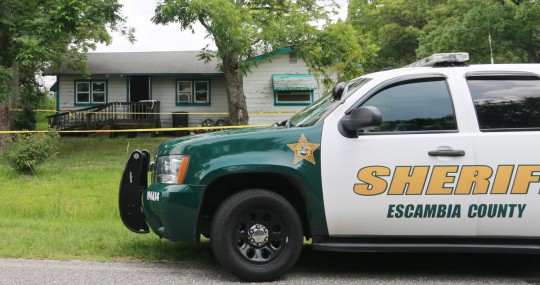 Christopher Alan Stacey was seated on a bucket across the road from the residence watching as investigators processed the crime scene, while his son sat ina wooden chair in front of a neighboring home (both pictured below). Cain and Jessica Thomas were placed in the back of ECSO patrol vehicles as investigators worked.
Christopher Alan Stacey was seated on a bucket across the road from the residence watching as investigators processed the crime scene, while his son sat ina wooden chair in front of a neighboring home (both pictured below). Cain and Jessica Thomas were placed in the back of ECSO patrol vehicles as investigators worked.
Florida investigators also responded to the truck at Brushy Creek on Deere Creek Road in Alabama to process that crime scene with Alabama agencies. The straight-line location of the truck was about 1,000 feet north of the Alabama-Florida State line.
Christopher Alan Stacey, resides with Thomas at the home on Highway 164. Boutwell told law enforcement that he was shot because of an argument with her ex-husband. The son, Christopher James Logan Stacey, also resides in the home, the report states.
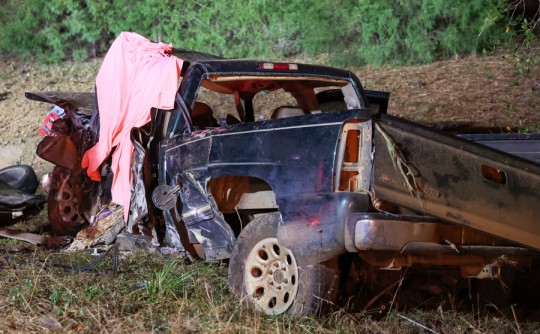 Boutwell, the victim that survived the July 2018 shooting, was killed in a single vehicle wreck on March 13, 2021, on Highway 4A about three miles west of Century. He was pronounced deceased at the scene; there were no passengers in the vehicle. [Read more...]
Boutwell, the victim that survived the July 2018 shooting, was killed in a single vehicle wreck on March 13, 2021, on Highway 4A about three miles west of Century. He was pronounced deceased at the scene; there were no passengers in the vehicle. [Read more...]
Pictured below: Christopher Alan Stacey was seated on a bucket across the road from the residence watching as investigators processed the crime scene, while his son James Logan Stacey sat on a wooden chair in front of a neighboring home. Pictured middle below: A deputy questions Jessica Thomas as she sits inside a patrol vehicle in Walnut Hill. Pictured bottom: Investigators say two men were shot inside this home on Highway 164 in Walnut Hill. NorthEscambia.com exclusive photos, click to enlarge.
International Paper Awards $66,450 in Grants To Local Organizations
December 5, 2023
International Paper’s Pensacola Mill has awarded $66,450 in International Paper Foundation grants to 30 local organizations, demonstrating the company’s commitment to education, hunger, health and wellness, disaster relief and initiatives that improve the planet.
“Through these grants, we aim to be catalysts for positive change, investing not just in projects, but in the collective well-being of the community,” said Hunter Morris, Pensacola Mill Manager. “These funds will play a crucial role in supporting community-driven projects aimed at addressing hunger, promoting health and wellness, enriching children’s education, and providing disaster relief assistance.”
- Ascension Sacred Heart Foundation – Pediatric Programs and Services
- Boys and Girls Club of the Emerald Coast – Club time is MIND! Time
- Bright Bridge Ministries – Hot, Healthy Meals
- Capstone Adaptive Learning and Therapy Centers – Music and Movement – Ready for Kindergarten
- Children’s Home Society – Battle of the Books for Literacy and Learning Gains
- Council on Aging of West Florida – Educational Student Composting Kits
- Covenant Care – My Wish to Terminally Ill Children and Adults
- Embrace Florida Kids – Milton Girls Home
- Ernest Ward Middle School – Get Agriculture, Forest the Rest
- Escambia County Medical Society Foundation – Blood Pressure Cuff Program
- Escambia County Public Schools Foundation – Tools for Teachers
- Feeding the Gulf Coast – Mobile Pantry Program
- Greater Pensacola Symphony Orchestra – Escambia and Santa Rosa County Fifth Grade Concerts
- Gulf Coast Kids House – The Healing Garden
- Health and Hope Clinic – Increase Access to Care
- Jim Allen Elementary – Developing Readers through Targeted Instruction
- Keep Pensacola Beautiful – Youth Advocacy Council/Envirothon
- Manna Food Bank – Healthy Kids Initiative
- Molino Park Elementary – Small Group Technology Materials
- Northwest Florida Community Outreach – Replenish for the Finish
- Pace Center for Girls – IP Reach Girls!
- Pensacola Little Theatre – Black Art in Pensacola: Connecting Diverse Art and Literacy
- Pensacola Mess Hall – Family Science Night Enhancements
- Pensacola State College Foundation – Pirates Care: Emergency Preparedness and Food Assistance
- ReadyKids! – Ready to Read
- Ronald McDonald House of Northwest Florida – Home for Dinner
- The Global Corner – Let’s Visit Mexico: An Activity Book for Young Explorers
- United Way of Baldwin County – Reading Buddies
- University of West Florida Historic Trust – Pensacola Children’s Museum Kids Emergency Room
- Valerie’s House – No Child Grieves Alone, Group Night Activities
- Ascension Sacred Heart Foundation – Pediatric Programs and Services
- Boys and Girls Club of the Emerald Coast – Club time is MIND! Time
- Bright Bridge Ministries – Hot, Healthy Meals
- Capstone Adaptive Learning and Therapy Centers – Music and Movement – Ready for Kindergarten
- Children’s Home Society – Battle of the Books for Literacy and Learning Gains
- Council on Aging of West Florida – Educational Student Composting Kits
- Covenant Care – My Wish to Terminally Ill Children and Adults
- Embrace Florida Kids – Milton Girls Home
- Ernest Ward Middle School – Get Agriculture, Forest the Rest
- Escambia County Medical Society Foundation – Blood Pressure Cuff Program
- Escambia County Public Schools Foundation – Tools for Teachers
- Feeding the Gulf Coast – Mobile Pantry Program
- Greater Pensacola Symphony Orchestra – Escambia and Santa Rosa County Fifth Grade Concerts
- Gulf Coast Kids House – The Healing Garden
- Health and Hope Clinic – Increase Access to Care
- Jim Allen Elementary – Developing Readers through Targeted Instruction
- Keep Pensacola Beautiful – Youth Advocacy Council/Envirothon
- Manna Food Bank – Healthy Kids Initiative
- Molino Park Elementary – Small Group Technology Materials
- Northwest Florida Community Outreach – Replenish for the Finish
- Pace Center for Girls – IP Reach Girls!
- Pensacola Little Theatre – Black Art in Pensacola: Connecting Diverse Art and Literacy
- Pensacola Mess Hall – Family Science Night Enhancements
- Pensacola State College Foundation – Pirates Care: Emergency Preparedness and Food Assistance
- ReadyKids! – Ready to Read
- Ronald McDonald House of Northwest Florida – Home for Dinner
- The Global Corner – Let’s Visit Mexico: An Activity Book for Young Explorers
- United Way of Baldwin County – Reading Buddies
- University of West Florida Historic Trust – Pensacola Children’s Museum Kids Emergency Room
- Valerie’s House – No Child Grieves Alone, Group Night Activities
Grants were determined after careful committee review with local team members. Recommendations are subsequently reviewed by the International Paper Foundation’s grants committee, which then must be confirmed and ratified by the foundation’s board of trustees.
Photos for NorthEscambambia.com, click to enlarge.
Escambia County Contracting With Town Of Century For Library Lawn Maintenance, Christmas Lights
December 5, 2023
Escambia County is set to enter into an interlocal agreement with the Town of Century for lawn maintenance at the Century Branch Library.
The Century Branch Library and the Century Town Hall share a common lawn. Century employees will provide lawn maintenance at the library at a cost of $300 per month. In addition, the town will install Christmas lights on the library to match those at the town hall at a cost not to exceed $150.
Century is required to maintain liability insurance during the one year contract. The town council has already approved the agreement, and the Board of County Commissioners will consider it on December 7.
NorthEscambia.com file photo, click to enlarge.
Northview FFA Students Build Duck Boxes For Jones Swamp
December 5, 2023
Northview High School FFA Chapter students built duck boxes that were recently installed by Escambia County Natural Resources Management at Jones Swamp.
Wood ducks typically nest in tree cavities, but boxes provide suitable nesting sites in urbanized areas and can help attract ducks to local wetlands, according to the county. Wood ducks begin to pair up in January, with nesting starting in the early spring, so the Natural Resource Management Division is hoping to welcome some new feathered friends to the neighborhood soon.
Photos for NorthEscambia.com, click to enlarge.


